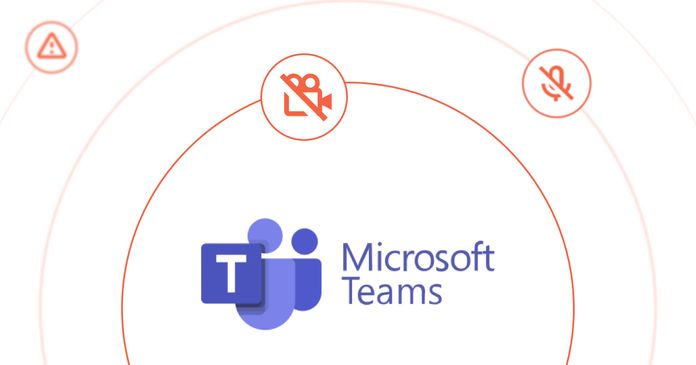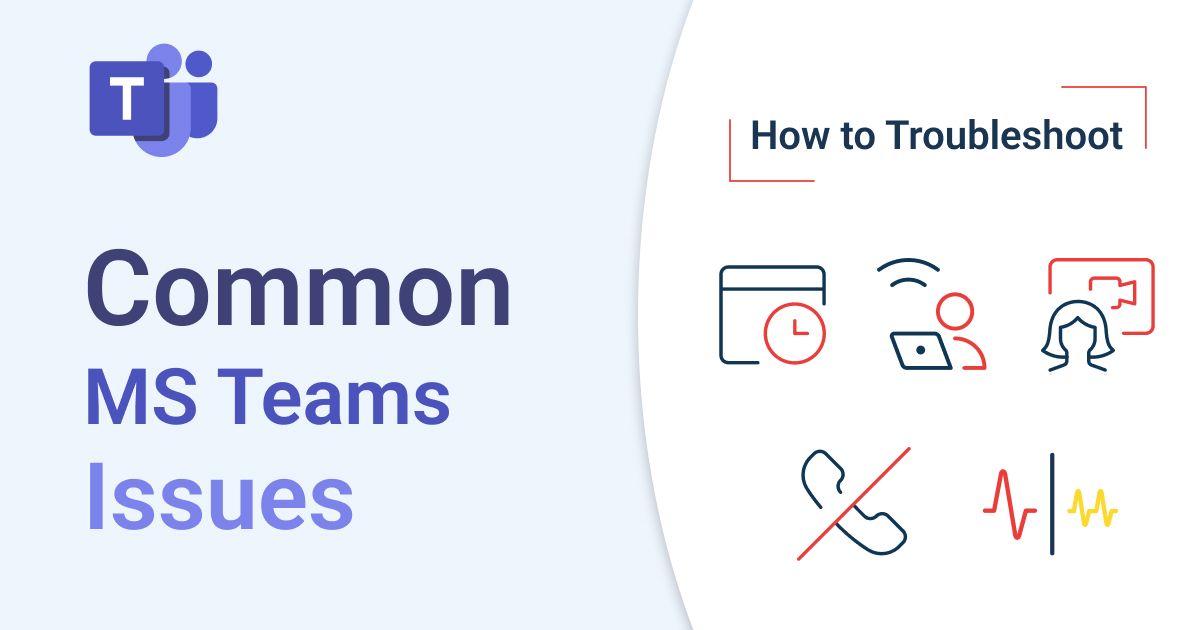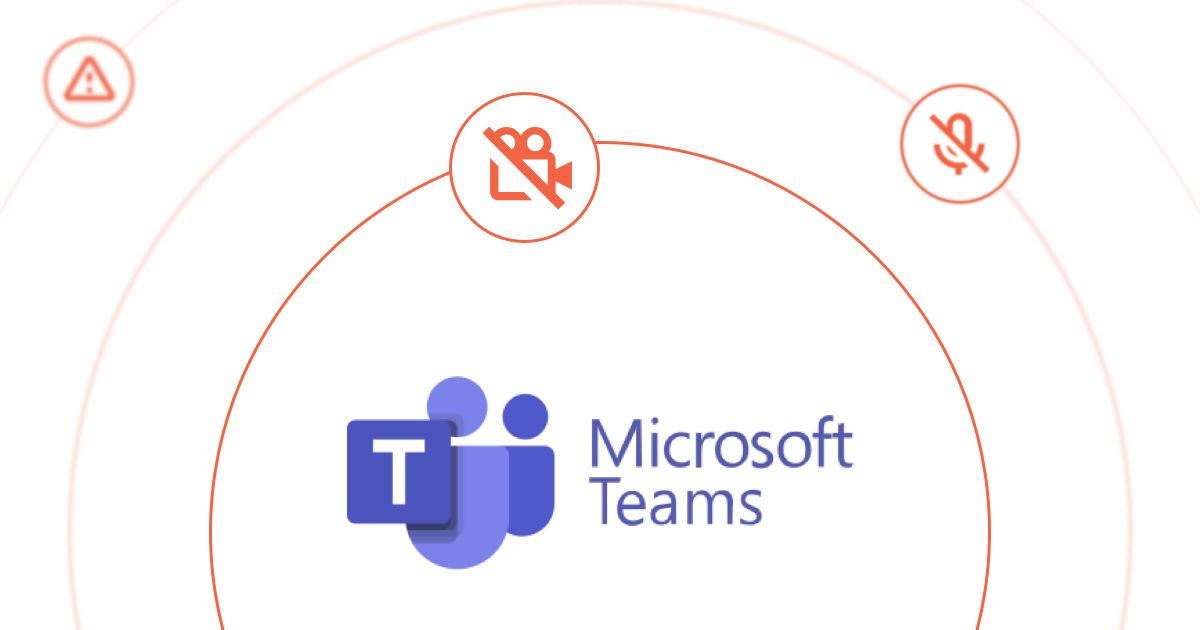Table of Contents
Table of Contents
Welcome to the world of Microsoft Teams! When it comes to video conferencing and messaging, Microsoft Teams is one of the most popular players in the game. When we get error messages like Microsoft Teams “We're sorry—we've run into an issue,” or “something went wrong,” it’s important to have a tool to help monitor and troubleshoot Microsoft Teams performance issues and connection issues.
Don't panic - these frustrating error messages are a common occurrence, and with the right tools and knowledge, you can easily diagnose and fix any issues that might be plaguing your Teams experience. In this blog post, we'll walk you through how to monitor Microsoft Teams issues with network monitoring, as well as some helpful tips and tricks for monitoring Teams issues and resolving the infamous "We're sorry" error. So grab a cup of coffee, sit back, and get ready to become a Teams monitoring master!
Microsoft Teams is widely used for personal use, and by companies of all different sizes.
So when your Microsoft Teams experience becomes affected by error messages like Microsoft Teams “we're sorry—we've run into an issue,” “hang on while we get things set up for you,” or “something went wrong,” it can be very frustrating.
Monitoring Microsoft Teams performance is crucial to ensure that the platform is running smoothly and efficiently. Here are a few reasons why monitoring Teams performance is important:
- Enhance User Experience: By monitoring Teams performance, you can identify and fix any issues that might be impacting user experience. This can help ensure that your users can collaborate seamlessly and effectively without any hiccups.
- Reduce Downtime: Teams downtime can be costly for businesses. By monitoring performance, you can proactively identify and resolve issues before they escalate into major problems, reducing the risk of downtime and lost productivity.
- Identify Trends: Monitoring Teams performance can help you identify trends over time, such as peak usage times, common issues, and recurring problems. This can help you make informed decisions about how to optimize and improve your Teams environment.
- Meet SLAs: If you have service level agreements (SLAs) in place, monitoring Microsoft Teams performance metrics is essential to ensure that you're meeting those commitments. By monitoring performance, you can quickly identify and resolve issues that might impact SLAs.

Stop guessing why Teams is slow. Obkio's specialized Microsoft Teams Monitoring Tool uses synthetic meetings to test performance every 60 seconds, monitoring from three perspectives: user devices, network infrastructure, and Microsoft's platform.
75% of Teams issues are network-related. Which makes network performance monitoring essential.

- Deploy in just 10 minutes
- Monitor performance in all key network locations
- Covers 99% of the Teams call path ✓ Detects issues before users complain ✓ Synthetic testing – no active calls required

Whether you’re working from the office, or working remotely from home, there are certain Microsoft Teams issues you'll have undoubtably be familiar with. After all, they pop up when you least expect them to and interrupt your most important meetings.
By monitoring your Microsoft Teams performance, you can easily identify and troubleshoot some of the most common Microsoft Teams issues like:
Microsoft Teams outage issues (disconnecting): When Microsoft Teams is down, users may experience issues with logging in, connecting to meetings or calls, or accessing the platform altogether. Microsoft Teams outages can happen due to a variety of reasons such as server issues, maintenance or upgrades, or network problems.
Microsoft Teams performance issues (constant freezing and buffering): If Microsoft Teams is running slow or experiencing buffering, it can impact the user experience during calls, meetings or chat sessions. This could be due to a lack of bandwidth or network connectivity, high CPU usage, outdated hardware, or software conflicts.
Microsoft Teams connection issues: Connection issues can cause problems with establishing or maintaining a connection to Microsoft Teams. This could be due to network connectivity issues, firewalls or security settings, outdated software or firmware, or hardware issues such as malfunctioning routers or modems.
Microsoft Teams login issues: Login issues can cause users to be unable to access their Teams account or join meetings or calls. This could be due to incorrect login credentials, account access restrictions, issues with the user's device or browser, or account-specific issues such as subscription or licensing problems.
Microsoft Teams only showing older messages and chats: This issue can occur when users are not receiving new messages or are only seeing older messages and chats. This could be due to syncing issues, network connectivity problems, or corrupted cache or data files.
Microsoft Teams not receiving notifications: If users are not receiving notifications for new messages or calls, they could be missing important information or missing out on meetings or calls. This could be due to notification settings being turned off, issues with the user's device or browser, or network connectivity issues.
Microsoft Teams Slowness: Microsoft Teams Slowness refers to the experience of delays, lags, or sluggish performance when using the Microsoft Teams collaboration platform. This slowness can manifest in various ways, such as slow loading times for chat messages, delays in joining or starting meetings, choppy audio or video during calls, and overall responsiveness issues within the application.
If you’re working from the office, there may be an IT team there to help troubleshoot, but they still need the information to identify and troubleshoot Microsoft Teams issues.
With working from home, IT teams need a way to help remote users troubleshoot network problems from home. Here’s how!
To continuously monitor Microsoft Teams and network performance so you can proactively identify Microsoft Teams issues and fix error messages like "We're sorry - we've run into an issue," you need a tol that's fit for the job.
Obkio's specialized Microsoft Teams Monitoring Tool is purpose-built to monitor Teams performance from every angle.
Unlike generic network monitoring solutions, Obkio's dedicated Microsoft Teams Monitoring Tool combines comprehensive network performance monitoring with Teams-specific synthetic testing. This approach monitors Microsoft Teams performance 24/7 through actual simulated Teams meetings, providing complete visibility into your Teams environment even when no real users are on calls.
Obkio's agent-based solution uses continuous synthetic testing to proactively monitor Teams performance. Here's how it works:
- Obkio's Monitoring Agents join actual Microsoft Teams meetings
- Exchange synthetic audio and video data for 35 seconds
- Test performance from the Agent's point of view
- Connect to Microsoft's API to download detailed call quality reports
- Repeat this cycle every 60 seconds for continuous monitoring

Obkio monitors Microsoft Teams performance from three critical perspectives:
- User Perspective: Monitors workstation resources (CPU, memory, network card performance) to ensure devices have adequate resources for Teams
- Network Perspective: Tracks network metrics like latency, jitter, packet loss, and bandwidth between users and Microsoft's infrastructure
- Microsoft API Perspective: Connects to Microsoft's API to gather detailed call quality reports and server-side performance data
With coverage of up to 99% of the Teams call path, Obkio provides end-to-end visibility from your users' devices, through your network infrastructure, across your ISP, and all the way to Microsoft's Azure data centers. This allows you to:
- Detect Teams issues before users complain
- Distinguish between user problems, network issues, and Microsoft platform problems
- Identify the exact source of performance degradation
- Collect concrete evidence for troubleshooting and escalation

Obkio monitors Microsoft and Network performance with synthetic traffic using Network Monitoring Agents. These unique agents can be deployed in all ends of your network to measure network metrics, identify network problems and collect the information to help you troubleshoot.
To monitor Microsoft Teams, you need to use Obkio’s Microsoft Azure Monitoring Agent.
The Microsoft Azure Monitoring Agent is hosted and maintained by Obkio in the Microsoft Azure cloud infrastructure, which means that they can be deployed within seconds.
This Monitoring Agent allows you to monitor network performance between your standard Monitoring Agents and Azure Monitoring Agents, right to the Microsoft Azure platform to identify any network problems affecting Microsoft Teams performance.
For more information about deploying this Monitoring Agent type, refer to our Documentation.
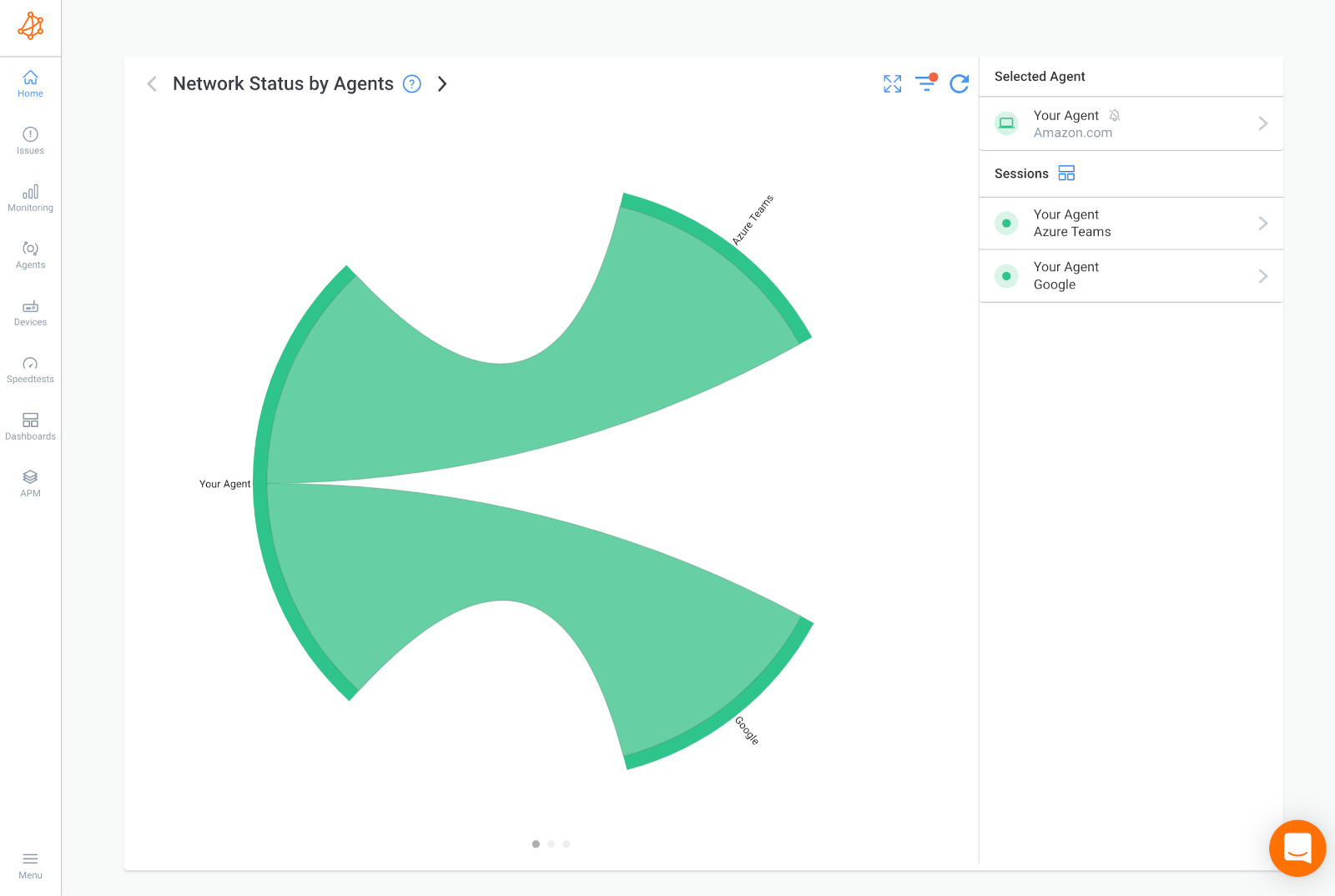
P.S. You can also use this Agent for general Azure Network Monitoring.
Microsoft Teams stores customer data in Microsoft's global cloud locations. So to identify Microsoft Teams issues, it’s important to choose a Monitoring Agent which has been deployed in the Data Center located closest to the Microsoft Data Center closest to you.
For Example: You want to monitor Microsoft Teams performance for your business based in Canada, so first, you need to find the location of a Microsoft Data Center in Canada.
In Canada, Microsoft's Data Centers are located in Quebec City and Toronto - so you need to choose a Public Monitoring Agent hosted closest to one of those locations.
Obkio’s Microsoft Azure Monitoring Agents are presently located in many locations, including one in Quebec City!
So when you’re deploying your Agent, make sure to choose the Quebec City Azure Agent, to monitor the performance of your Microsoft Teams from Microsoft’s Quebec City Data Center!
You should always deploy a minimum of two Agents to more accurately compare data and accurately identify Microsoft Teams issues.
For example, if you’re monitoring Microsoft Teams network performance between your head office and your Internet, use one Agent in your Head Office and 2 Agents to monitor Internet performance (example, an Azure Agent and an AWS Agent).
This way, if you have a network problem, you can easily see if that same problem is affecting all your sites or just one.
If the problem is affecting all your sites, having multiple Agents allows you to collect the most accurate data to troubleshoot, as well as create a comparison point.
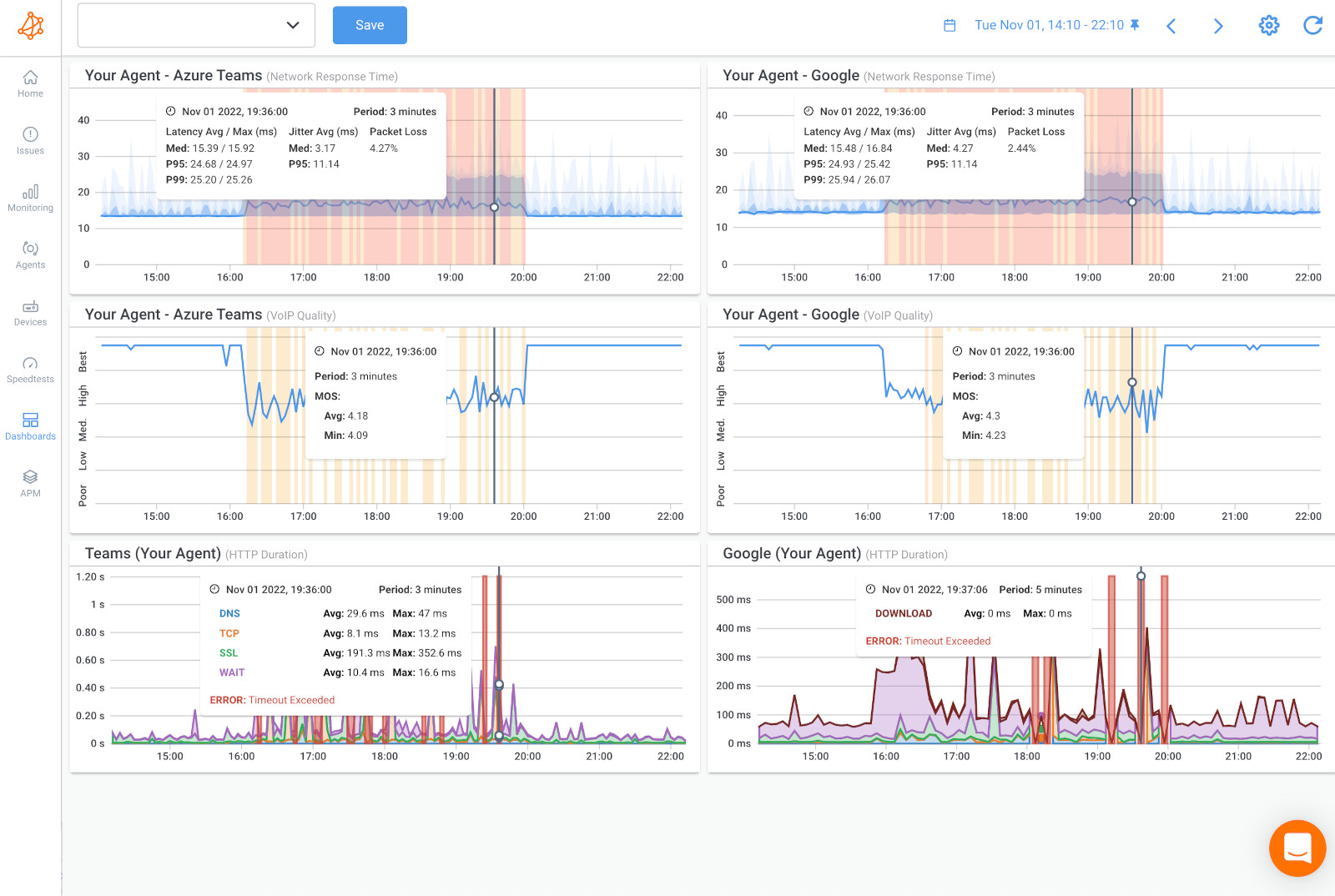 Obkio Dashboard with a Microsoft Teams issue on 2 Network Sessions.
Obkio Dashboard with a Microsoft Teams issue on 2 Network Sessions.
Once you’ve set up your Microsoft Monitoring Agent and followed Obkio's Onboarding Wizard, you now have a Microsoft Teams network monitoring tool! Your Monitoring Agents will then start to continuously exchange synthetic UDP traffic between each other to monitor performance and Teams performance in your network.
While network performance monitoring is essential for Teams, Obkio's specialized Microsoft Teams Monitoring Tool takes it several steps further by actually testing Teams functionality itself, not just the network connection. This means collecting data from a variety of different metrics like:

These metrics monitor the devices running Microsoft Teams to ensure they have adequate resources for smooth performance.
CPU Usage: CPU is the percentage of processing power being used on the device. Teams is resource-intensive, requiring significant CPU for video encoding, audio processing, and screen sharing. High CPU usage (over 85%) leads to choppy video, delayed audio, and frozen screens. Acceptable levels stay under 70%.
Memory (RAM) Availability: The amount of available memory for Teams to store temporary data like chat history, video buffers, and meeting information. Teams requires a minimum of 4GB RAM, with 8GB+ recommended. Low memory causes slow loading, delayed messages, crashes, and sluggish performance when switching between chats and meetings.
Disk Usage and I/O: Measures how busy the hard drive is with reading and writing data. Teams constantly accesses the disk for downloading messages, caching video streams, and storing temporary meeting data. High disk usage (over 95%) results in slow app loading, delayed file access, and lag when opening chat threads. SSDs perform significantly better than older mechanical hard drives.
These metrics measure the quality of the connection between users and Microsoft's servers—the "highway" Teams data travels on.
Latency: Latency measures the time it takes for data to travel from the user's device to Microsoft Teams servers and back, measured in milliseconds. High Microsoft Teams latency creates the delay between speaking and being heard. Under 150ms provides natural conversation flow, while over 300ms causes awkward pauses and people talking over each other.
Packet Loss Packet Loss measures the percentage of data packets that get lost during transmission and never reach their destination. Each packet contains pieces of video, audio, or data. Packet loss over 2% causes video freezing, choppy audio, and missing words. Even 1-2% begins affecting quality noticeably.
Jitter: Jitter measures the variation in delay between packets arriving at their destination, measured in milliseconds. High jitter (over 50ms) disrupts the steady flow of data Teams needs, causing robotic or choppy audio, video and audio to become out of sync, and inconsistent call quality that fluctuates between good and bad.
Bandwidth: Bandwidth measures the total capacity of the internet connection and how much is currently being used. Teams requires 1.5 Mbps minimum per user, with 3+ Mbps recommended for HD video. Insufficient bandwidth forces Teams to lower video quality automatically, prioritize audio over video, or drop video entirely.
Quality of Service (QoS) QoS measures how well the network prioritizes Teams traffic over other types of traffic during congestion. Proper QoS configuration ensures Teams voice and video get priority, like a "fast lane," so calls remain smooth even when large downloads or streaming video compete for bandwidth. Without QoS, Teams competes equally with everything else on the network.
These metrics are gathered by joining actual Teams meetings and connecting to Microsoft's API, providing insights into Teams functionality itself.
VoIP Quality & MOS (Mean Opinion Score) MOS is an overall score from 1-5 that predicts user satisfaction by combining latency, jitter, packet loss, and codec quality into a single metric. Scores above 4.0 indicate excellent call quality where conversations feel natural. Scores below 3.1 mean calls are nearly unusable with constant frustration.
Audio Quality, Latency, and Jitter: Tracks the clarity of voice, presence of echo or distortion, and specific delays in audio packet delivery. Audio latency under 100ms is imperceptible, while over 200ms disrupts conversation. Audio jitter under 20ms is excellent; over 40ms causes robotic voice and words cutting out. Audio is the most critical component—people can tolerate poor video, but poor audio makes communication impossible.
Video Quality, Latency, and Jitter: Monitors resolution achieved, frame rate, pixelation, and delays in video frame delivery. Video latency under 150ms maintains good sync with audio, while over 300ms makes lips visibly mismatched with words. Video jitter under 30ms provides smooth motion; over 50ms creates jerky, stuttering playback. Poor video quality results in blurry faces, frozen frames, and choppy motion.
Average Call Quality Score: A comprehensive score combining all aspects of the Teams call—audio, video, network metrics, and user environment. This overall health indicator provides an at-a-glance understanding of Teams performance, making it easy to quickly assess whether calls are meeting quality standards.
The power of Microsoft Teams monitoring lies in correlating these metrics to instantly diagnose issues.
When high CPU usage coincides with poor call quality but network metrics are normal, the problem is the user's underpowered device.
When high latency and packet loss align with poor MOS scores but user metrics are normal, it's a network issue.
When Microsoft API returns errors and meetings fail to create despite normal network and user metrics, it's a Microsoft platform issue.
This correlation eliminates guesswork and points directly to the source of problems, whether user-related, network-related, or on Microsoft's end.

This end-to-end visibility ensures you can identify issues no matter where they occur in the complex Teams ecosystem, from the device in someone's home office all the way to Microsoft's data centers.
Network performance can have a significant impact on the performance of Microsoft Teams, as it is a cloud-based collaboration platform that relies heavily on a stable and fast Internet connection. That's why using a Network Performance Monitoring tool, like Obkio, is important to identifying and addressing Microsoft Teams issues.
If the network performance is poor, it can cause the following issues with Microsoft Teams:
- Poor audio and video quality: If the network is slow or unstable, it can result in poor audio and video quality during meetings, leading to a frustrating user experience.
- Delays and lag: Slow network performance can cause delays and lag in Microsoft Teams, making it difficult to have real-time conversations and collaborate effectively.
- Connectivity issues: A weak network connection can cause intermittent connectivity issues, leading to dropped calls or disconnections from meetings.
- Slow loading times: Slow network performance can also cause slow loading times when launching Microsoft Teams or accessing files, leading to delays and decreased productivity.


Obkio can help identify Microsoft Teams issues by providing visibility into network performance and monitoring the key network metrics that impact Microsoft Teams performance.
Here are a few ways Obkio can help:
- Real-time alerts: Obkio can send real-time network monitoring alerts when network metrics like latency, packet loss, or jitter exceed certain thresholds. These alerts can help IT teams proactively identify and troubleshoot issues that may be affecting Microsoft Teams performance.
- Historical analysis: Obkio provides historical analysis of network metrics, allowing IT teams to identify trends and patterns over time. This can help identify persistent issues that may be affecting Microsoft Teams performance.
- End-to-end visibility: Obkio provides end-to-end visibility into network performance, from the user's device to the Microsoft Teams server. This can help IT teams identify the source of any issues that may be affecting Microsoft Teams performance.
- Automated testing: Obkio performs continuous automated network testing using synthetic traffic to simulate user activity on Microsoft Teams. This can help identify any issues with the network that may be impacting Microsoft Teams performance.
- **Microsoft Teams Network Assessment: Obkio can help you perform a Microsoft Teams network assessment to uncover any potential issues and ensure your network can support Microsoft Teams service before and after a deployment.
By using Obkio to monitor network performance, IT teams can ensure that Microsoft Teams is running smoothly and delivering a high-quality collaboration experience.
Now that you have Obkio monitoring the performance of your network, your Microsoft Teams application, and the Microsoft cloud, you can use the information Obkio collects to identify what Microsoft Teams issues are affecting performance, where they are happening, when they happened, and why.
You can check out our article on Microsoft Teams Troubleshooting for the next step:
Learn how to use Network Monitoring tools for Microsoft Teams troubleshooting to identify and fix common teams performance and connection issues.
Learn more

To begin troubleshooting your Microsoft Teams issue, you need to first understand: Is it really a network problem?
To do this, you’ll need to compare the monitoring sessions between the Azure Public Monitoring Agent and the other Public Monitoring Agent you deployed.
- A Network Issue On 2 Sessions: If you find a Microsoft Teams issue happening on 2 network sessions, this means that the issue is happening on a network segment that is common to both network sessions. The issue is broader, not exclusive to Zoom and affects all services and applications that depend on the network. This could be in the LAN, the firewall or the local loop Internet connection.

- A Network Issue On 1 Session: If you find a Microsoft Teams issue happening on only 1 network session, This means that the network problem is happening specifically towards that specific location on the Internet and that the problem is further away.
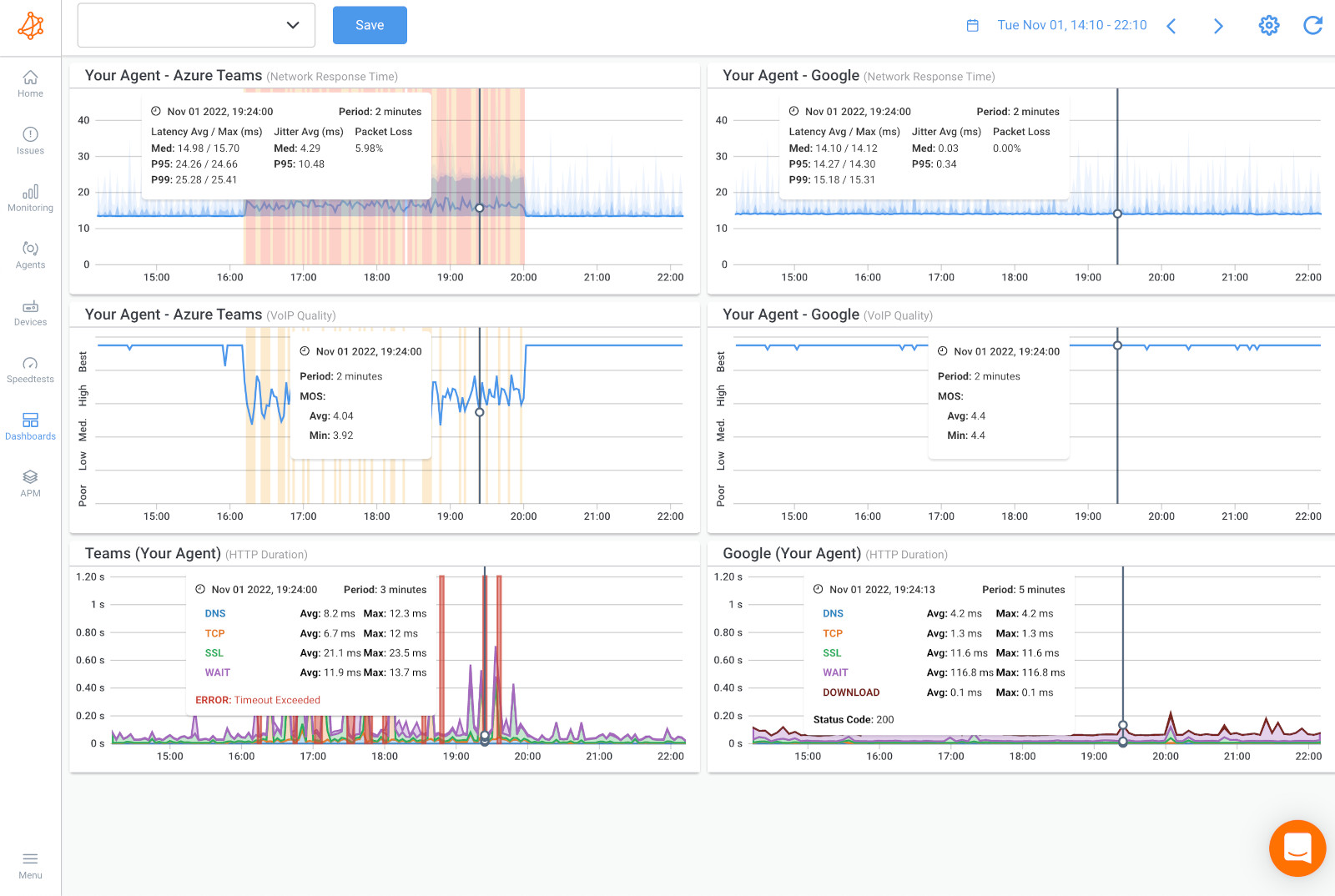
If the issue is happening on both network sessions, compare that data using Obkio’s Device Monitoring feature to further understand if the Microsoft Teams issue is happening on your end, or over the Internet, in your Service Provider’s network.
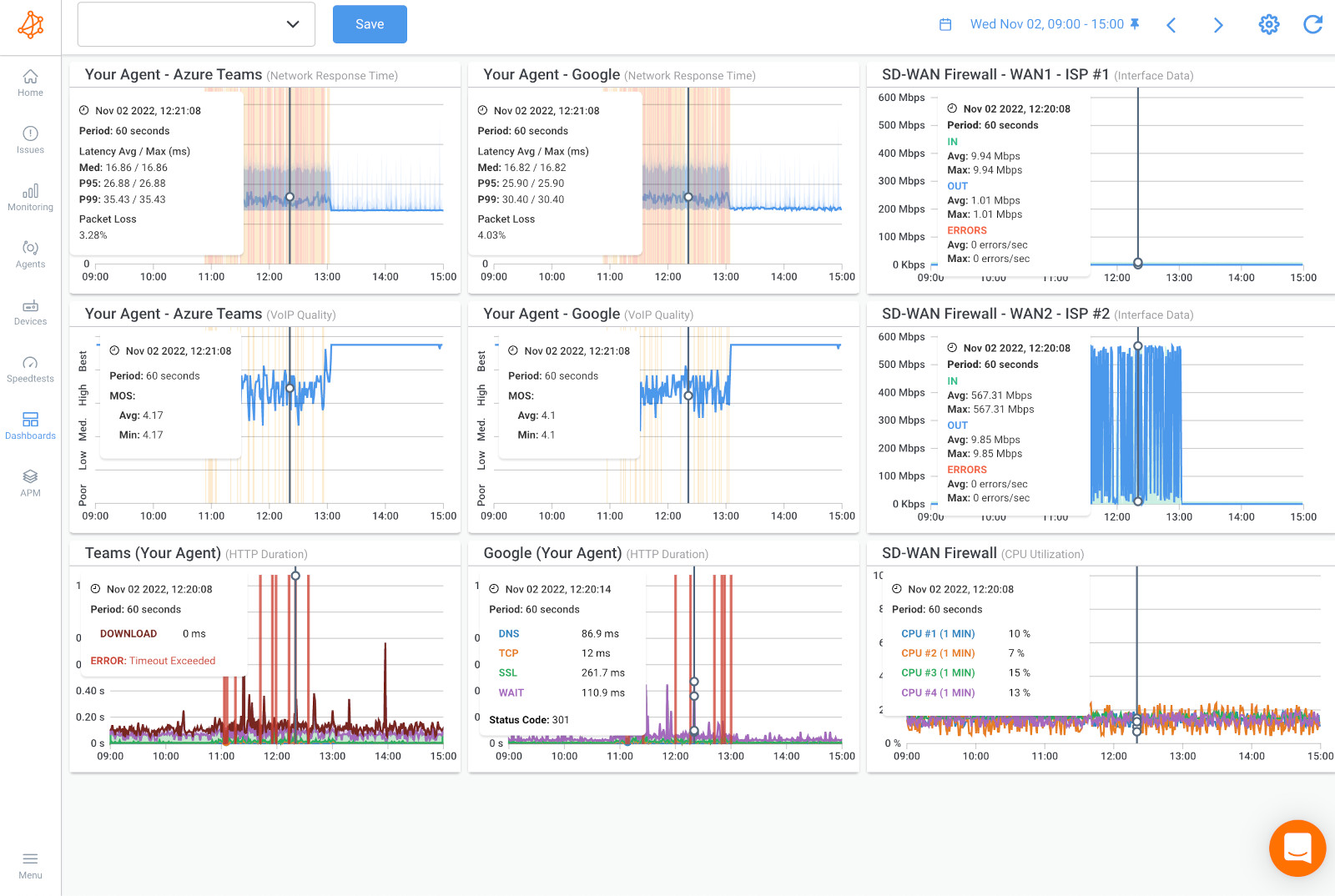
- CPU or Bandwidth Issues: When you compare your data using Device Monitoring, if you find CPU or Bandwidth issues, this likely means that the problem is on your end and you need to do troubleshoot with your internal team.
- Internet Problems in Your ISP’s Network: If you don’t see any resource issues from your devices, this is a sign that the network problem affecting your Microsoft Teams performance is in your Service Provider’s network. In this case, you need to open a service ticket with as much information as you can collect. And, for your request to be taken seriously and be quickly escalated past 1st level support, you need to share as much information as you can.
You can now collect the last bit of data about where exactly the network problem is located so you can share that information with your Service Provider. To do this, we’ll use Obkio Vision, Obkio’s free Visual Traceroute tool.
By using Traceroutes, the Network Map, and the Quality Matrix you’ll be able to identify if:
- The issue is happening specifically towards a specific location over the Internet. So only one specific site is being affected.
- The issues is on your ISP’s side and you need to open a service ticket with as much information as you can collect.
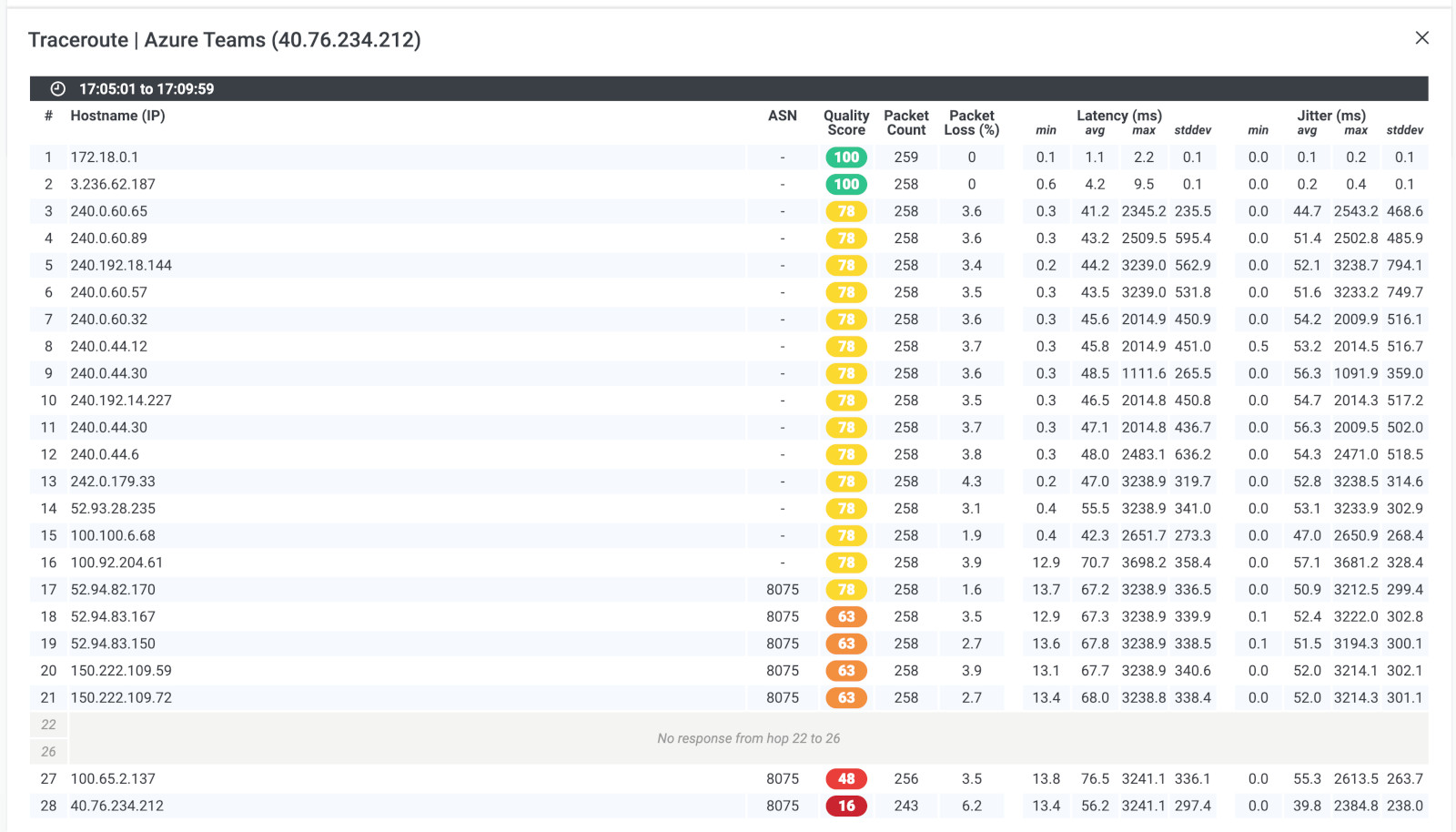
If the problem is in your ISP's Network:
- Contact your ISP to get technical support using the screenshots of Monitoring Sessions, Dashboards or Traceroutes in Vision.
- Share results of Live Traceroutes with your ISP using a public link.
- If your ISP wants to analyze your data further, you can create a temporary Read-Only User in your Obkio account for them.
One major part of the troubleshooting process is understanding what caused the Microsoft Teams issues to happen. Luckily, Obkio takes out all the guesswork by telling and showing you exactly the cause of performance issues, why they happened, when and where.
Using Obkio's Visual Traceroutes and Network Device Monitoring feature are your best tools to identifying and fixing the most common causes of Microsoft Teams performance issues. But to give you a head start, here are some of the most common causes:
- High network latency: High network latency can cause delays and interruptions during calls and meetings. This can make it difficult to have a smooth and productive collaboration experience.
- Packet Loss: Packet loss occurs when network packets are lost during transmission, which can cause audio and video quality issues during calls and meetings.
- Jitter: Jitter is the variation in the delay between packets arriving at their destination. High VoIP jitter especially can cause audio and video quality issues during calls and meetings.
- Insufficient bandwidth: Insufficient bandwidth can cause delays and interruptions during calls and meetings, especially if multiple users are using Microsoft Teams simultaneously.
- Firewall and proxy issues: Firewall and proxy issues can prevent Microsoft Teams from connecting to the internet or communicating with the Microsoft Teams server, causing connection issues and service disruptions.
- Outdated network hardware: Outdated network hardware, such as switches or routers, may not be capable of handling the demands of modern collaboration tools like Microsoft Teams, causing performance issues.
By following the steps above, you'll have now determined exactly and what causing those annoying Microsoft Teams issues, and who is responsible for troubleshooting: You or your ISP.
If your ISP is on the job, the information you provide from Obkio will be enough to escalate your case. You can then use Obkio to monitor your Microsoft Teams performance later to see if the issue was actually resolved.
If the issue is happening in your business' network, here are some best practices for solving Microsoft Teams issues:
- Check for service outages: Before troubleshooting any issues, check the Microsoft Teams Service Health page to see if there are any known outages or service disruptions. If there is an outage, you may need to wait for Microsoft to resolve the issue.
- Identify the scope of the issue: Determine if the issue is affecting a single user or a group of users. If it's a single user, the issue may be specific to that user's device or network connection. If it's a group of users, the issue may be related to the network or Microsoft Teams configuration.
- Check network connectivity: Check the user's network connectivity to ensure that they have a stable Internet connection. You can use tools like ping and traceroute to test network connectivity or tools for network connectivity monitoring.
- Check firewall and proxy settings: Ensure that the user's firewall and proxy settings are configured correctly to allow traffic to and from the Microsoft Teams service.
- Check Microsoft Teams logs: Microsoft Teams logs can provide valuable information about any errors or issues that are occurring within the app. You can access these logs by clicking on your profile picture in Microsoft Teams, selecting Help, and then choosing Open Logs Folder.
- Update Microsoft Teams: Ensure that the user's Microsoft Teams app is up to date. Outdated versions of the app can cause performance issues and may not be compatible with newer features.
- Contact Microsoft support: If you're unable to resolve the issue on your own, contact Microsoft support for assistance. Be prepared to provide detailed information about the issue, including any error messages or symptoms.
By following these best practices, you can effectively troubleshoot Microsoft Teams issues and ensure that your users have a high-quality collaboration experience.
If you're reading this article, there's a chance you've encountered the error message: "We’re sorry - we’ve run into an issue," and you're probably to fix it. Of course, this issue can be caused by a variety of network and Internet problems, which you'll likely uncover and troubleshoot using the steps above.
But, here are some moretargered steps you can take to fix the "We’re sorry - we’ve run into an issue" error message in Microsoft Teams:
- Restart Microsoft Teams: Sometimes, simply restarting Microsoft Teams can fix the issue. Close the app completely and then reopen it to see if the error message goes away.
- Clear the cache and cookies: Clearing the cache and cookies can sometimes resolve issues with Microsoft Teams. To do this, click on your profile picture in Microsoft Teams, select Settings, and then choose Privacy. Click on Clear Cache and Clear Cookies to clear your cache and cookies.
- Update Microsoft Teams: Ensure that you have the latest version of Microsoft Teams installed. Outdated versions of the app can cause issues and may not be compatible with newer features.
- Check your Internet connection: Make sure you have a stable Internet connection. You can test your connection using an online speed test tool to ensure that your connection meets the recommended minimum bandwidth requirements for Microsoft Teams.
- Disable add-ins: Some add-ins may interfere with Microsoft Teams and cause the error message to appear. Try disabling any add-ins you have installed and see if the error message goes away.
- Reinstall Microsoft Teams: If none of the above steps work, try uninstalling and reinstalling Microsoft Teams. This can often fix issues that are related to corrupted files or settings.
- Contact Microsoft support: If you're still experiencing the issue after trying these steps, contact Microsoft support for assistance. Be prepared to provide detailed information about the issue, including any error messages or symptoms.
By following these steps, you can often resolve the "We’re sorry - we’ve run into an issue" error message and get back to using Microsoft Teams without interruptions.


Avoiding Microsoft Teams issues and maintaining a high-performing Microsoft Teams environment requires ongoing attention to several factors. Real-time and unified applications like Microsoft Teams and Zoom and highly sensitive to network issues - so performance issues are bound to happen. Especially in businesses with remote employees that rely heavily on Microsoft Teams to communicate.
Here are some tips for maintaining a high-performing Microsoft Teams environment:
- Monitor network performance: Network issues can have a significant impact on Microsoft Teams performance. Monitor network metrics such as latency, jitter, and packet loss to identify any issues and take steps to resolve them.
- Use QoS policies: Quality of Service (QoS) policies can help ensure that Microsoft Teams traffic is prioritized on your network, which can improve performance and reduce the impact of network congestion. QoS for VoIP is especially helpful here.
- Ensure sufficient bandwidth: Ensure that your network has sufficient bandwidth to support Microsoft Teams traffic, especially if multiple users are using the application simultaneously. You can use traffic shaping or bandwidth management tools to ensure that Microsoft Teams traffic is prioritized over other types of traffic.
- Keep software up-to-date: Ensure that you are using the latest version of Microsoft Teams and that all other software on your system is up-to-date. Outdated software can cause compatibility issues and may not support newer features.
- Optimize hardware: Ensure that your hardware is optimized for Microsoft Teams. For example, use high-quality headsets and webcams for better audio and video quality, and ensure that your computer meets the minimum system requirements for Microsoft Teams.
- Educate users: Educate your users on how to use Microsoft Teams effectively, including how to optimize their audio and video settings, how to troubleshoot issues, and best practices for using the application.
- Conduct regular testing: Regularly test your Microsoft Teams environment to ensure that it is performing as expected. This can help identify any issues before they become major problems and help ensure that your users have a consistent and reliable collaboration experience.
By monitoring network performance, ensuring sufficient bandwidth, using QoS policies, optimizing hardware, educating users, keeping software up-to-date, and conducting regular testing, you can help ensure that your team has a consistent and reliable collaboration experience with Microsoft Teams.
In the end, monitoring and maintaining a high-performing Microsoft Teams environment may seem like a daunting task, but with the right tools and practices, it can be a breeze. By following the tips outlined in this post, you can ensure easily fix some of the most common Microsoft Teams issues and esnsure that your team's collaboration experience with Microsoft Teams is top-notch and free from any pesky error messages.
Traditional network monitoring only tells part of the story. Obkio's specialized approach combines network performance monitoring with synthetic Teams testing that actually joins meetings every minute and exchanges real audio/video data. This is paired with three-perspective analysis that monitors user environments, network paths, and Microsoft's platform simultaneously—covering 99% of the Teams call path.

With your end-to-end monitoring setup powered by Obkio's specialized Teams monitoring, you don't have to worry about Microsoft Teams disconnecting, lagging, and freezing during calls anymore. You'll be prepared with:
- Continuous Visibility: 24/7 monitoring through synthetic Teams meetings with real-time alerts
- Instant Diagnosis: Three-perspective correlation analysis showing exactly where issues originate
- Faster Resolution: Pinpoint whether problems are user-related, network-related, or on Microsoft's end
- Proactive Prevention: Identify issues before users complain and detect gradual performance degradation
You don't have to panic when you receive error messages like "we're sorry—we've run into an issue" or "something went wrong." With Obkio's specialized monitoring, you'll have real-time visibility into Teams performance metrics, historical context to understand if issues are new or recurring, and clear diagnostics pointing to the exact cause.
With Obkio's network monitoring tool and specialized Microsoft Teams monitoring capabilities, you can continuously monitor your network and Microsoft Teams app to proactively identify outages, performance issues, and connection problems—all while troubleshooting in minutes, even when supporting remote workers from home.



























 Obkio Blog
Obkio Blog




